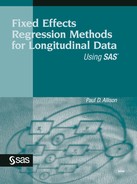3.4. Fixed Effects versus Random Effects
As with the linear models in chapter 2, the most popular alternative to the fixed effects model is a random effects model. That model begins with an identical equation:
Solving for pit, this can also be written as
Now, instead of assuming that αi is a fixed constant, we assume that it is a random variable with the following properties:
Models of this sort can be handled with PROC NLMIXED, which estimates a variety of nonlinear mixed models.[] Let's apply it to our poverty example:
[] As of this writing, SAS also offers an experimental procedure called GLIMMIX that might be an attractive alternative to NLMIXED. For the models discussed in this chapter, GLIMMIX has a much simpler syntax and is less computationally intensive. On the other hand, the algorithms used by GLIMMIX might be less accurate than those used by NLMIXED, especially when the number of observations per person is small.
PROC NLMIXED DATA=teenyrs5;
eta=b0 + byr1*(year=1)+ byr2*(year=2) + byr3*(year=3) +
byr4*(year=4) + bmother*mother + bspouse*spouse +
bschool*inschool + bhours*hours + alpha;
p=1/(1+ EXP(-eta));
MODEL pov~BINARY(p);
RANDOM alpha ~ NORMAL(0,s2) SUBJECT=id;
PARMS b0=−.29 byr1=−.06 byr2=.16 byr3=.09 byr4=.09
bmother=.99 bspouse=−1.26 bschool=−.24 bhours=−.03 s2=1;
RUN;The program begins by defining a linear function ETA of the explanatory variables, including a random component denoted by ALPHA. Note that each coefficient must be given a name. I've chosen names that incorporate the name of the variable so that the output is more easily interpreted. Also notice the treatment of YEAR. Since NLMIXED doesn't have a CLASS statement, I've used logical expressions like YEAR=1 to define dummy variables for the first four out of five years.
The next statement defines the probability P of an event as a logistic function of ETA, as in equation (3.6). The MODEL statement says that the response variable POV has a Bernoulli distribution with parameter P (equivalent to a binomial distribution with N=1). The RANDOM statement says that there is a different random variable ALPHA for each value of the ID variable. These random variables all have normal distributions with a mean of 0 and a common variance S2. Finally, the PARMS statement sets starting values for all the parameters in the model. For the coefficients, these starting values were obtained from a simple logistic regression model estimated in PROC LOGISTIC.
Estimation of this random effects model required about 40 seconds of computer time on my PC, much longer than the fixed effects model, which ran in slightly under six seconds. Results in Output 3.9 show both similarities and differences with the fixed effects estimates in Output 3.7. The effects of motherhood and spouse are substantially larger in magnitude here than they were in Output 3.7. On the other hand, the estimate for school enrollment is much smaller and no longer statistically significant.
| Parameter Estimates | |||||||||
|---|---|---|---|---|---|---|---|---|---|
| Parameter | Estimate | Standard Error | DF | tValue | Pr>|t| | Alpha | Lower | Upper | Gradient |
| b0 | −0.5082 | 0.1121 | 1150 | −4.53 | <.0001 | 0.05 | −0.7281 | −0.2883 | 0.000809 |
| byr1 | −0.1722 | 0.1152 | 1150 | −1.49 | 0.1353 | 0.05 | −0.3982 | 0.05385 | 0.000011 |
| byr2 | 0.1146 | 0.1103 | 1150 | 1.04 | 0.2989 | 0.05 | −0.1018 | 0.3310 | −0.00045 |
| byr3 | 0.05395 | 0.1058 | 1150 | 0.51 | 0.6102 | 0.05 | −0.1536 | 0.2616 | −0.00009 |
| byr4 | 0.08755 | 0.1034 | 1150 | 0.85 | 0.3971 | 0.05 | −0.1152 | 0.2903 | −0.00006 |
| bmother | 1.0769 | 0.1185 | 1150 | 9.09 | <.0001 | 0.05 | 0.8445 | 1.3093 | −0.00006 |
| bspouse | −1.2386 | 0.1521 | 1150 | −8.14 | <.0001 | 0.05 | −1.5370 | −0.9402 | −0.00006 |
| bschool | −0.06457 | 0.09802 | 1150 | −0.66 | 0.5102 | 0.05 | −0.2569 | 0.1278 | 0.000652 |
| bhours | −0.02672 | 0.002872 | 1150 | −9.30 | <.0001 | 0.05 | −0.03236 | −0.02109 | 0.007776 |
| s2 | 1.4490 | 0.1420 | 1150 | 10.20 | <.0001 | 0.05 | 1.1704 | 1.7277 | 0.000012 |
Why the differences? Well, the important thing to keep in mind is that the random effects estimates in Output 3.9 do not control for any time-invariant variables, whereas the fixed effects estimates in Output 3.7 control for all time-invariant variables. Although time-invariant variables could be added to the random effects model, only those variables that are actually present in the data set can be statistically controlled.
